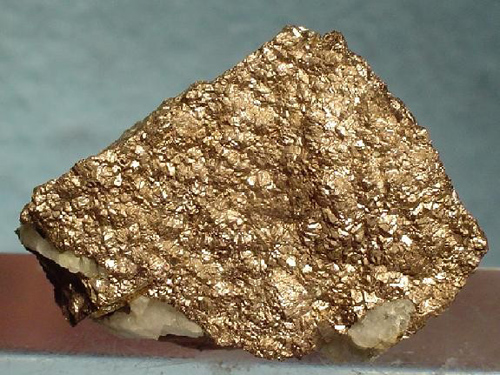The Mineral nickeline

Nickeline is named for its nickel composition, being one the primary nickel minerals. In the 1600's, it was thought to have contained copper due to its bronze color, and was known as
kupfernickel ("kupfer" is copper in German.) It was officially named Nickeline by French
mineralogist Francois Sulpice Beudant in 1832, and subsequently renamed Niccolite by James Dwight Dana in 1868, derived from the latin work for nickel. Both terms are still used to describe this mineral, though Nickeline is the more prevalent term.
Color
Bronze to copper-red. tarnishes gray to dark gray.
Properties
Streak
Dark brown to black |
Hardness
5 - 5.5 |
Transparency
Opaque |
Specific Gravity
7.8 |
Luster
Metallic |
Cleavage
None |
Fracture
Conchoidal to Uneven |
Tenacity
Brittle |
Crystal Habits
Nickeline crystals are uncommon. When they do occur, they are in hexagonally-shaped crystals that are prismatic with pyramidal terminations, or in tabular or stubby hexagons. Crystals are always small and usually in aggregates or plates. Most commonly massive, reniform, plumose, as crusts, as patches and splotches in host rock, and in veins.
Uses
Nickeline is an ore of nickel. Crystallized specimens from the German locality of Eislebeln are considered rare classics, and specimens from the Cobalt, Ontario area are sometimes sliced into slabs for collectors.
Noteworthy Localities
Nickeline in the form of small crystals are well-known from Eislebeln, Saxony-Anhalt, Germany. Other important localities include the Jáchymov District in the Krušné Hory Mountains, Bohemia, Czech Republic; Bou Azer, Morocco; and the Trotter Mine in Franklin, Sussex Co., New Jersey. Massive Nickeline is prevalent at in Ontario, Canado, at the ore-rich localities of Cobalt, Timiskaming District; and in the Sudbury District.
Distingushing Similar Minerals
The unique metallic-bronze color of Nickeline is very distinguishable and make this mineral hard to be confused with other minerals. An exception is Breithauptite (nickel antimonide), which is chemically and structurally similar to Nickeline, and often is indistinguishable without complex testing.